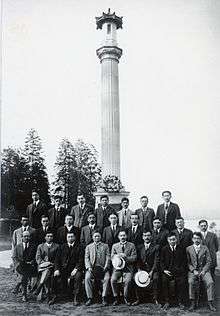East Asian Canadians
East Asian Canadians are Canadians with ancestry, origins, or citizenship from East Asia. The term East Asian Canadian is a subgroup of Asian Canadians. According to statistics Canada, East Asian Canadians are considered visible minorities and can be further divided by nationality, such as Chinese Canadian, Hong Kong Canadian, Japanese Canadian, Korean Canadian, Mongolian Canadian, Taiwanese Canadian or Tibetan Canadian.
| Total population | |
|---|---|
| 2,140,920[1] 6.2% of the total Canadian population (2016) | |
| Regions with significant populations | |
| Southern Ontario, Southwestern BC, Central Alberta, Montreal, Most urban areas | |
| Languages | |
| Canadian English · Canadian French · Mandarin · Cantonese · Korean · Japanese · Min Nan Other East Asian Languages | |
| Religion | |
| Buddhism · Christianity · Irreligion | |
| Related ethnic groups | |
| Asian Canadians · East Asians in the United Kingdom · Asian Americans |
As of 2016, 2,140,920 Canadians had East Asian geographical origins, constituting 6.2% of the Canadian population and 34% of Canada's Asian Canadian population.
Terminology
East Asian Canadians are typically identified under the term "Asian"; popular usage of this term in Canada generally excludes both West and South Asians, instead solely referring to individuals of East Asian ancestry.
History
_in_Mountains%2C_1884.jpg)

The first record of East Asians in what is known as Canada today can be dated back to 1788 when renegade British Captain John Meares hired a group of Chinese carpenters from Macau and employed them to build a ship at Nootka Sound, Vancouver Island, British Columbia. After the outpost was seized by Spanish forces, the eventual whereabouts of the carpenters was largely unknown.
In the mid-late 19th century, early settlers from East Asia (China and Japan) emigrated to Canada, predominantly settling in British Columbia.
Demography
| Province / territory | Population | Percentage |
|---|---|---|
| 1,003,750 | 7.6% | |
| 678,105 | 14.9% | |
| 231,810 | 5.8% | |
| 139,925 | 1.8% | |
| 37,685 | 3% | |
| 22,840 | 2.1% | |
| 12,495 | 1.4% | |
| 6,565 | 0.9% | |
| 3,105 | 2.2% | |
| 2,955 | 0.6% | |
| 810 | 2.3% | |
| 710 | 1.7% | |
| 140 | 0.4% | |
| 2,140,920 | 6.2% |
Ethnic and national origins
| 2016[1] | ||||||
|---|---|---|---|---|---|---|
| Number | % | |||||
| 1,769,1951 | 82.6% | |||||
| 198,210 | 9.3% | |||||
| 121,485 | 5.7% | |||||
| 36,510 | 1.7% | |||||
| 8,040 | 0.4% | |||||
| 7,480 | 0.3% | |||||
| Total population | 2,140,920 | 100% | ||||
| 1Including Hong Kong Canadians. | ||||||
See also
References
- "Census Profile, 2016 Census Canada [Country] and Canada [Country]". Statistics Canada. Retrieved May 20, 2020.
- "Census Profile, 2016 Census Ontario [Province] and Canada [Country]". Statistics Canada. Retrieved May 20, 2020.
- "Census Profile, 2016 Census British Columbia [Province] and Canada [Country]". Statistics Canada. Retrieved May 20, 2020.
- "Census Profile, 2016 Census Alberta [Province] and Canada [Country]". Statistics Canada. Retrieved May 20, 2020.
- "Census Profile, 2016 Census Quebec [Province] and Canada [Country]". Statistics Canada. Retrieved May 20, 2020.
- "Census Profile, 2016 Census Manitoba [Province] and Canada [Country]". Statistics Canada. Retrieved May 20, 2020.
- "Census Profile, 2016 Census Saskatchewan [Province] and Canada [Country]". Statistics Canada. Retrieved May 20, 2020.
- "Census Profile, 2016 Census Nova Scotia [Province] and Canada [Country]". Statistics Canada. Retrieved May 20, 2020.
- "Census Profile, 2016 Census New Brunswick [Province] and Canada [Country]". Statistics Canada. Retrieved May 20, 2020.
- "Census Profile, 2016 Census Prince Edward Island [Province] and Canada [Country]". Statistics Canada. Retrieved May 20, 2020.
- "Census Profile, 2016 Census Newfoundland and Labrador [Province] and Canada [Country]". Statistics Canada. Retrieved May 20, 2020.
- "Census Profile, 2016 Census Yukon [Territory] and Canada [Country]". Statistics Canada. Retrieved May 20, 2020.
- "Census Profile, 2016 Census Northwest Territories [Territory] and Canada [Country]". Statistics Canada. Retrieved May 20, 2020.
- "Census Profile, 2016 Census Nunavut [Territory] and Canada [Country]". Statistics Canada. Retrieved May 20, 2020.